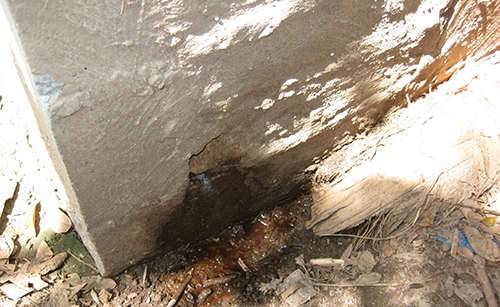How to Find a Water Leak

Water leaks in your home are could be costing you a lot of money on your water bill. If it seems like your water bill is higher than usual and your water usage has remained the same then there is likely a leak somewhere on your property. Leaks can also cause serious water damage to your home if left unchecked which is why we always recommend hunting down those pesky leaks as soon as you notice the signs. With our help, you’ll be experienced in water leak detection in no time.
Narrow Down the Source of the Leak
First things first, let’s figure out if the leak is somewhere inside your home or is in the supply lines between the meter and your house.
- Turn off the water to your house using your home’s shut off valve. It’s usually outside your home close to the exterior wall
- Once the water is shut off, find your meter head. If it isn’t visible try digging around near the meter. Sometimes dirt or grass will cover it.
- Watch the meter to see if it is still turning
- If the meter isn’t turning then the leak is somewhere inside your house and you can move on to another section of this article.
- If the meter is still turning then the leak is in between the meter and your house or it could be that the shutoff valve to your home is leaking
- Walk between the meter and the house shutoff valve and look for muddy areas or places where the grass is growing much more than other areas of the lawn. If you find these chances are you’ve found where the leak is. Make sure to check the house shutoff valve as well.
Check your Irrigation System for Signs of Leaks
The pipes in your home’s sprinkler system are pretty fragile compared to other pipes in your home so if you’ve experienced unexplained spikes in your water bill your irrigation system could be the culprit. Follow the path that the pipes in your sprinkler system would take and look for the same signs such as muddy areas or areas with grass higher than the rest. If you find anything then you likely have a broken sprinkler pipe underground that is leaking. Your garden hose bibs could be the culprit as well. Even a minor drip leak can really add up over time according to this calculator from USGS. You can get a replacement hose bib from a home improvement store for less than 10 dollars and it could save you a lot on your water bills. Just make sure to shut off the water before you unscrew the hose bib.
Watch the Ceiling for Signs of Water Leaks
Dark spots on the ceiling of your first floor is a sure sign that you have a water leak somewhere on the second floor of your home, ceiling water damage can be very serious. The source of the leak could be leaking toilet supply lines or a bathroom drain. To help determine where the leak is, measure out from the wall to the center of the stain on the ceiling. Stains are usually pretty close to the source of the leak so this will give you a better reference of where to look when you go upstairs. Once you have the measurement go upstairs and measure out from the same wall and figure out which fixture is closest to the measurement you took. Whatever is closest is likely the culprit. If a toilet is closest, check the supply lines and shutoff valves on the supply lines. Sometimes fixing your leak is as easy as changing out the shutoff valves or the rubber gaskets in the lines. If a bathroom faucet is closest, check the supply lines under the sink like you would for a toilet, but also check the drain pipes to make sure that they aren’t the source of the leak.
Watch out for Signs of a Slab Leak

Slab leaks occur underneath the concrete foundation (or slab) of your home which makes them very hard to locate because none of the pipes are visible. If you suspect you have a slab leak call a professional plumber immediately. Slab leaks can ruin the foundation of your home if they aren’t dealt with fast enough. There are a few ways to keep an eye out for them so you can catch them before they become too serious. For starters watch for areas of your flooring that are hotter or colder than the rest of the room. If water is spraying out under the slab the hot or cold water could change the temperature of areas of the floor. Look for areas of concrete outside your home that are persistently wet like in the picture above as well. If you see any of these signs call someone right away. Since leaks in the pipe can’t be found with a visual inspection you will need a professional plumber with specialized tools to pinpoint the leak. The only other option is to break up your foundation at random looking for the leak which is a terrible idea.









